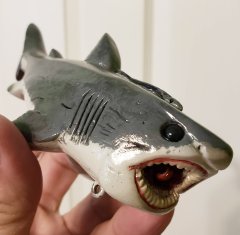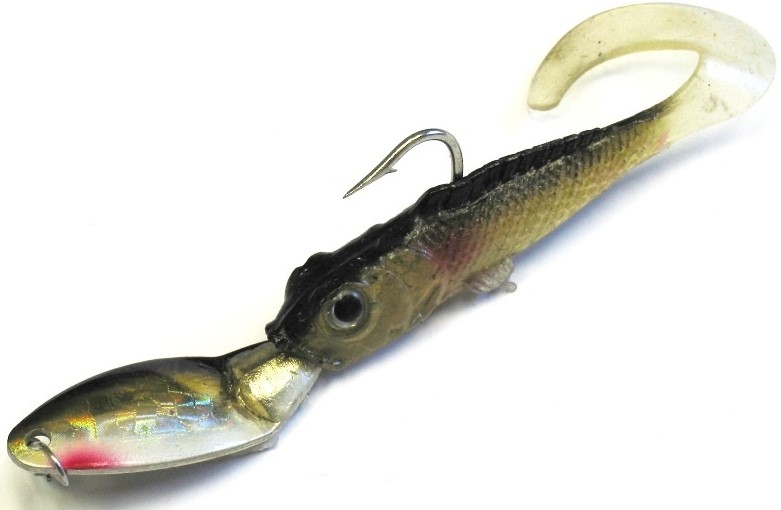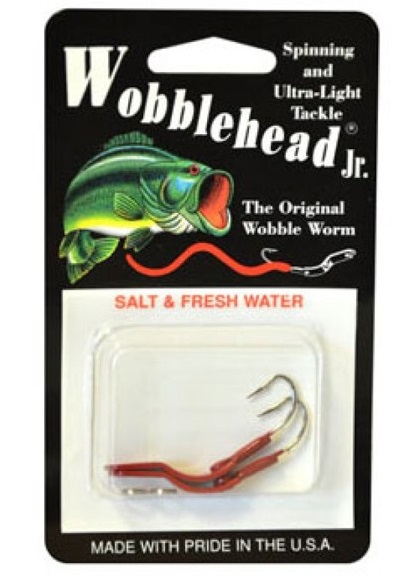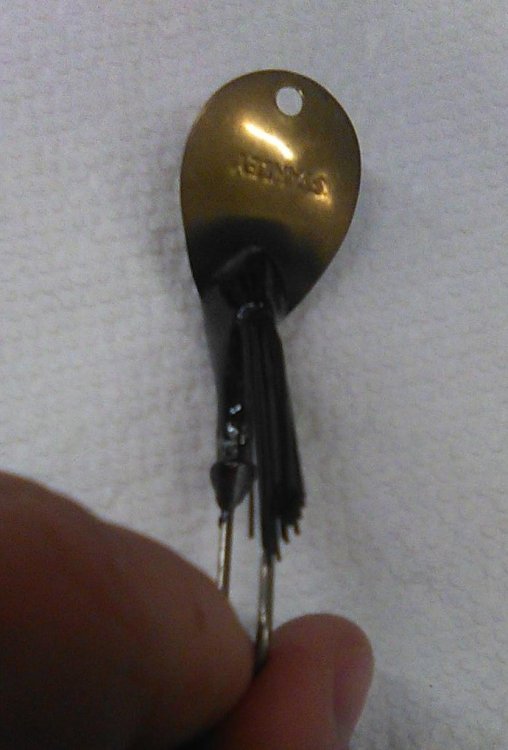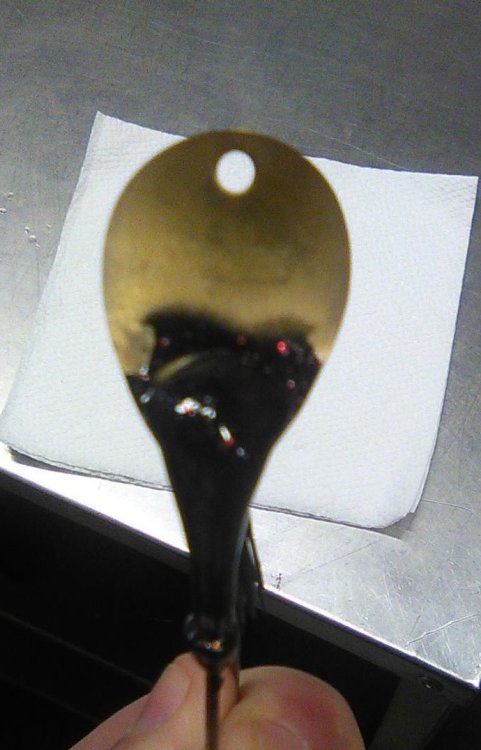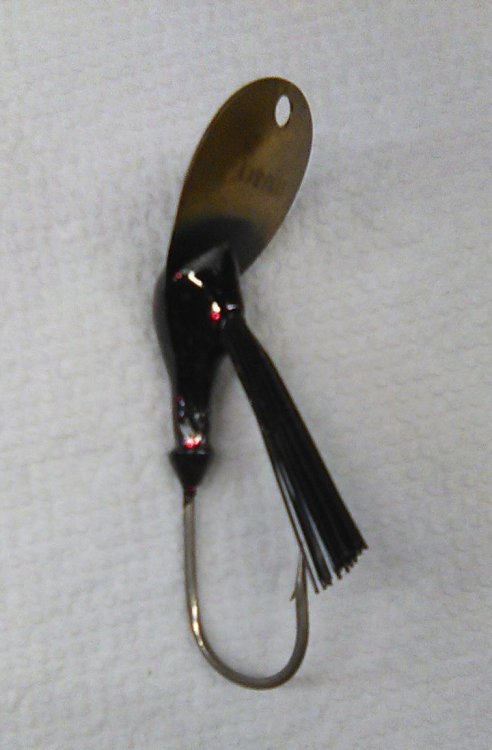
JD_mudbug
TU Member-
Posts
419 -
Joined
-
Last visited
-
Days Won
55
Content Type
Profiles
Articles
TU Classifieds
Glossary
Website Links
Forums
Gallery
Store
Everything posted by JD_mudbug
-
I also mostly make baits over 6" up to 12". I typically use the LPO .092 stainless screw eyes for a pre-made screw eye. I will use .072 if I make less than 6" bait. Occasionally, I will make a bait over 12". On the largest baits, I have used up to 2.5" inch long screw eyes when there is room in the body. Most of my current baits are made with .051 or .062 stainless safety lock wire twist screw eyes or are wired-through. I sometimes use gate hardware screw eyes that I find in the assorted hardware racks of may local Ace hardware. These are the screws that are used to latch a gate or door in a wood frame. They are like size 208 to 212 screw eye but have a longer thread. These types of screw are great if you want a sloppy joint with a thick gauge screw eye that make a lot of noise like on the MS Slammer. I only use stainless screw eyes. I have a bad habit of not drilling a big enough pilot hole and snapping the non-stainless screw during installation. If fishing in musky or pike waters, I like to make a recessed cup in the lure body that the base of the eye on the screw can sit in. When I epoxy the bait, the part of the screw that can open gets covered in epoxy reducing the chances of it opening.
-
Have you tried disabling your pop-up blocker? Every so often, my posts don't go through because of that. One thing that worked for me was not going to the site directly from a browser or bookmark. I periodically save a notification email sent by the site. I get to the site by clicking on the 'go to this post' in the email. Once at the site, I go to the forum I want.
-
When you start painting plastic blanks, you may want to put some superglue around the hook hanger eyes and line tie eye. Some of the blanks may leak around those spots. Sometimes your paint and clear coat doesn't get in around the eyes to seal those spots. You can buy 30 cheap small arts & crafts paint brushes for $2 at walmart to smear the superglue around those spots. There are several suppliers who make those types of blanks. You can check the pinned post at the top of the hard bait forum. Here are some links https://www.sheltfishingtackle.com/shelts-rap-ko-shad-blanks-p-100.html https://lurebuild.com/ols/products/3-flicker-minnow https://fishheadcustomlures.com/d7-crankbait-chrome/ https://fishheadcustomlures.com/d7-crankbait/ https://backwateroutfitting.com/product/rap-crank-unpainted/ https://www.sugartitcustomlures.com/product-page/basic-5-shad I find the narrow rolls of painting tape to be useful when painting small blanks. 3M makes 1/8" (0.125") and 1/4" (0.25") rolls. https://www.amazon.com/3M-2090-0-125in-60yd-Masking/dp/B007Y7GPQU/ref=sr_1_10?crid=3Q6MY49OQXCYU&keywords=3M+2080+ScotchBlue+Painters+Tape+–+0.125+in.&qid=1702823144&s=industrial&sprefix=3m+2080+scotchblue+painters+tape+0.125+in.%2Cindustrial%2C112&sr=1-10 https://www.amazon.com/2090-ScotchBlue-Painters-Tape-Preparation/dp/B0079NPE6G/ref=sr_1_4?crid=NOB3GQWOLAX0&keywords=3M+2090+ScotchBlue+Painters+Tape+-+0.25+in&qid=1702823395&s=industrial&sprefix=3m+2090+scotchblue+painters+tape+-+0.25+in%2Cindustrial%2C104&sr=1-4
-
799280BF-B3F3-4E53-AC09-12EF9E09C8EB.jpeg
JD_mudbug commented on Flaswimbaiter's gallery image in Hard Baits
-
Help identifying this clip and if it can be purchased for making lures
JD_mudbug replied to Yawk's topic in Hard Baits
They are called 'connecting links'. Jann's has them. https://www.jannsnetcraft.com/335505 If you search for 'fishing connecting links' or 'sinker slider links', you should be able to find more suppliers. Sea Striker, Rosco and Luxon make them You can find them sometimes in saltwater tackle stores with the plastic sliding sleeve attached if you don't mind paying extra for the plastic sleeve you will not use. -
Don't forget the difficult-to-paint patterns such as the all-white and the all-black. And if you want to get truly artsy, you could add a bit of red to throat.
-
I have used a part of a feather cut into a tail shape, paint brush bristles, or a fin cut from a thin silicone place mat or under sink mat. These don't noticeably affect the action on my baits. I also make the tail fin slot wider at the end of the bait and cross pin the fin through holes in the fin that are bigger than the pins. The fin will flap with the motion of the bait. Similar to the tail fin mounting on the Black Dog G2 Shellcracker. See the post below. https://www.tackleunderground.com/community/topic/38362-jointed-lexan-tail-what-effect-does-it-have-if-any/#comment-313700 It is possible to make a flapping feather or bristle fin. I have done it by laying the feather or bristles out on a piece of scotch tape with just the mounting part of the fin on the tape. I then put epoxy on the part resting on the tape. Once the epoxy cures, I carefully peel off the tape and epoxy that side of the mounting part of the fin. Once that cures, I can drill holes in the epoxy part and cross pin in the bait. Sometimes the epoxy cracks and I have to fix it with a bit more epoxy. It's a pain to do, but can can give some really nice waving action even when the bait isn't moving.
-
The top bait is a Gary Yamamoto Chikara crankbait. The leaping bass in the pupil is the tell tale sign. The second bait is similar to a Mister Twister, Bandit or Bill Lewis crankbait. It could also be a knockoff. They all had a groove going down the body coming from the lip. Bandit and Bill Lewis typically had painted on eyes. My guess would be the Mister Twister crankbait because some of their baits had recessed eye sockets with flat tape eyes. I think the Mister Twister bait was called the SportFisher. It sometimes came with painted eyes and sometimes had the tape eye in a recessed socket.
-
I once got a bad pack of Gami Superline hooks. The points would bend over on the first fish. Even fishing with a wimpy spinning rod those hooks would bend over. I believe any hook manufacturer can get a bad batch of wire on occasion that can cause a run of bad hooks. Tactical Bassin has talked about it before. Start at 17:30 if you don't want to watch the whole video. https://www.youtube.com/watch?v=91EnJ0dGRXg&t=221s
-
I think the vintage schemes will work as well as the new ones except in a few situations. I think the action plus overall color scheme is more important in most situations than the detail. I paint some of the baits I make all white or all black. Sometimes I will add just a bit of red, orange or chartreuse to the throat. Those baits catch plenty of fish. Now if you are fishing in clear water using a jerkbait with pauses, I think the new realistic schemes will help as the fish can get a good look at the bait.
-
Marvel Cinematic Universe and also Moisture Cured Urethane. A one part clear coat like KBS and Dick Nite's.
-
I used to get to meet a lot of people in the industry. Over the past 20 plus years, I have met less and less people as the internet has taken over. Most of the local tackle shops disappeared in my area. There was less contact with the manufacturers because everything was switching to online and through large stores. A lot of people I knew have retired or went to different fields as the industry consolidated with mergers. I still work 3-5 regional fishing expos early in the year before ice out. The regional shows of today are nothing compared to the shows of the 80s and even the 90s. Back then all the manufacturers went all out to generate sales because they had to. My first fish caught on a lure was on the Mud-bug in the 70s when I was around 7. It has a square aluminum lip with rounded lobes on the leading edge and a bulbous butt. It sits close to a 45 degree angle in the water the lip down because of the reverse design. It is a hard wobbling squarebill that deflects well. If you stop the bait or pause it when it gets wedged on something on the bottom, it will float up going slightly away from you due to way it sits in the water. The backwards float often triggers hits and allows you to back out of some snags. The Seein's Believin' crawfish paint schemes still hold up against todays lures. Back in the 80s, it came in at least 7 sizes ranging from single treble flyrod/ultralight size to a trench digging 1-1/4 oz striper size. Fortunately, I was able to get a stockpile of discontinued baits from the various Ebsco (Pradco) brands that were sitting in a warehouse at the end the 90s . It's interesting fishing old baits like the Mud-bugs, Heddon Clatter Tapollys, Heddon Rivers Runts, and Creek Chub Wiggle Fish along with the modern stuff. I would love to see these lures comeback with updated hardware like the Jitterbug 2.0.
-
How bout this current one by Hynes Bay Outdoor Products. https://hookremover.com/ https://www.texassaltwaterfishingmagazine.com/fishing/hynes-bay-outdoor-products-swallowed-fishhook-remover
-
Just saw this post. I am not sure if the one of following hook removers are what you are thinking of. Hopefully, the pics in the links will be of help. Once you find the actual name, it should be easier to track one down. I know I had one of them at some point but can't find it. Rainbow's Shoot Out Hook Remover https://www.ebay.ca/itm/255783290966?hash=item3b8ddf4856:g:ExcAAOSwWfVjTtWb&amdata=enc%3AAQAIAAAA8K2cVIMPDre8SLkdNaaR46%2FYqi4OELNvp4hLbtFLZCduB521f2iyPqp5pFN8UyWLFDyuiLLCPZUgBoYbfI1XeAeNN6X68fInmN4hA0%2ByhXMaDc%2FuamNk2U0vl08EdBtfWLCvdZ5p8ETbScHFEr3IvllWqUf7Rdmc%2BSMKmhcr0rFWKrhhsEAqPJKGH%2BwzWyUn1emJGBqDeQAsEiny8HCNBn4Cuhb65gRquaNbVWgjx7GatD4XoJv0RfKqmB4NwO3nv3aJwOc71qbjY%2FVUELGzsZw2vmhhb3pEPobIrSpSC9ew%2Bvz4JsxDOJeLmIgS6J9MXQ%3D%3D|tkp%3ABFBMusGLpPth Hank Shawhan's Out-O-Matic Hook Remover https://www.etsy.com/listing/1417749691/vintage-hank-shawhans-out-o-matic-fish Double X Tackle Shoot Out Hook Remover https://www.ebay.com/p/1901029931
-
On the belly hook, you can try a T-type Treble like an Owner ST-35, KVD triple grip or other EWG treble where the points are slightly tipped in to reduce hook damage. You can make your own T trebles with pliers but be careful. Some hooks like Owner ST-36 are too stiff and snap when bent. If you are not careful, you could hook yourself or take a hook shard to the eye.
-
The old lipped jigs worked. There were several around 20-25 years ago. When the Chatterbait came on the scene in 2003 and became the hot bait, the other styles with the molded in blade lost popularity. Some baits are discontinued because the company has more profitable baits, the bait isn't as popular as a 'new' bait and sales drop, or a component becomes too expensive. Sometimes a corporate merger causes a reduction in a brand's product line. Sometimes it has nothing to do with how well a bait works. The Arbogast Mudbug is one of my favorite crankbaits. Works as good now as it did in the 80s. Other baits, like the modern square bills, became more popular, sales declined, there were numerous mergers, and it was discontinued. The Stanley lipped jig had a too stiff weed guard and a poor hook by today's standard. I don't think they even need a weed guard. You miss a lot of fish on it. Berkley made one called the Blade Dancer. It didn't have a skirt and had a grub-tail minnow designed for it. There was the Wobblehead that was typically fished with a Creme Scoundrel or other straight worm. They also could have benefitted from a better hook. The ones made now with the better hooks of today can be very effective. I have been using this one and really like it: https://www.rockyledgetackle.com/products/swimbait-jig I use a slow to medium steady retrieve. They have a certain range of retrieve speed where the action is great. I watch the jig coming in to find it. I use a trailer that has little resistance like a grub, half a trick worm, split tail spinnerbait trailer, or ribbon-tail worm with the head cutoff. Paddletails and craws have too much action on their own and can kill the action of the jig. It doesn't vibrate like a Chatterbait. It come in with a side to side sashay. They seem to work better in clearer water or less windy days when you need a more subdued presentation than a true vibrating bladed jig. I also think I have had good luck with them in pressured waters because everyone else is throwing a Chatterbait. I like them because they have very little retrieve pressure and the molded in blade helps them scoots over objects. They're great to fish if you hands are sore at the end of long day or multi-day trip.
-
Stanley Jigs also made some for a brief period probably around 20 years ago. They used a Colorado blade with a hole drilled in the wider end of the blade for a line tie. The skirt rotted away years ago. At the New England Fishing Expo 2 months ago, I bought some nice looking lipped jigs from Rocky Ledge Tackle out of New Hampshire.
-
I struggled with the regular skinz when they first came out. I had better luck with the ProSkinz and foil skinz which came out later. The skinz are not durable without a clear coat protecting them. Hook rash, impacts, and toothy fish can easily damage an unprotected skin. There is one video where epoxy is put on the body before the Jigskin. Then the skin is put on on with a heat gun or using a turkey baster to apply boiling water carefully. The epoxy cures and creates a bond between the skin and lure body. I would still put a topcoat clear on it. At 3:00 https://www.youtube.com/watch?v=x8LBi1H7gTc
-
I don't know about the vinyl paper. You could try water slide decal paper. I have used JigSkinz wraps. There are several youtube videos on them. They come in a variety of patterns. I like the foil ones in particular. You put the bait in the wrap which is a tube, hold with forceps/vicegrips, and dunk in boiling water (see below about using a heat gun to pre-shrink the head area before dunking) or you could try it with heat gun alone. They are essentially shrink tubing with lure patterns on the outside. D2T sticks well to them. It may take a couple of tries to get the hang of it. Use a sharp Xacto knife or razor blade to do any trimming. They run from $2 to $3.50. Price depends on size. They go up to 9" in length. https://www.lurepartsonline.com/Foil-JigSkinz https://www.lurepartsonline.com/JigSkinz-Real-Life-Series?quantity=1&custcol12=241 https://barlowstackle.com/lure-paint-lure-eyes-and-lure-adhesive-tape/jigskinz-proskinz/ Below is an old post on them. https://www.tackleunderground.com/community/topic/34295-wraps-skins-for-big-swimbaits/ From the link above: I have used the Jig Skinz Pro and the foil Jig Skinz on 6-12" Slammer type baits and other big jointed baits. I have done about a dozen so far. I do apply D2T for a clear coat after the skin is put on. On jointed baits with V cut joints, I have found it best to use a skin a 1-2 inches longer than the bait. I cut the skin into sections with each skin section slightly longer than each section of the bait. I make each skin section slightly longer than the bait section in case it shifts a bit when it shrinks. You can trim any extra with a razor knife after shrinking. I do the back (tail) section first. This way you can tuck that piece of the skin inside of the V cut of the section in front of the one you are covering . This way you can get coverage right up to the joint. Then, I work forward putting on a section of the skin one at a time. If you can, install the diving lip after the skin. Cutting a hole in the skin for the lip can be tough on a large bait. I cut the lip slot in the bait before skinning. You can cut out the skin covering the lip slot with an small razor knife. Skinz don't shrink completely even around the circumference of the bait. Sometimes it can be really noticeable at the eyes which can distort. Before dipping the front section of the skin, I have been hitting the the back (top) with a heat gun. This way only the top part of the skin will shrink reducing the chances the eyes will distort. After heating the back (top), I let it cool for a minute before dipping in the water. On a real big bait, I have used a couple of inches from the end of one skin to do the tail section of the bait. Then, I finish the bait with a full skin of the same color. You can use the remainder of the first skin on a smaller bait.
-
You may want to try lurebuild.com. They have some Xrap type blanks as well as some other salt water blanks. Their stock is low right now. Xrap type, slightly longer than a size 14 at 6”, 1.33 oz. Currently out of stock. https://lurebuild.com/ols/products/6-flash-minnow-160 Deep X rap blank in between a size 12 and 14 at 5”, 1 oz https://lurebuild.com/ols/products/update-pdt2 Reel Power Handles has 5 packs of unpainted clear Sebile Stick Shad KOs. 182mm, 3.75 oz. Lipless, but more of a jerkbait IMO. https://reelpowerhandles.com/products/1067_303855255075_31440_1ced1?_pos=4&_sid=d35f38983&_ss=r Painted 4 pack: https://reelpowerhandles.com/products/1067_312076953538_31440_1ced1?_pos=1&_sid=e978be5aa&_ss=r I don’t know where you are located or if you know anyone near Shreveport Louisiana. Bacon’s Tackle Shop has a bunch of big boxes of Rat-L-Traps. 1000s of bulk Traps. They are actual Rat-L-Traps in varying states of being finished from unpainted, to base coated, to foiled, to fully painted and cleared. They have no hooks and were being sold $2 each or 3 for $5. But, you will have to comb through the boxes for the magnum traps.
-
You're welcome. I just wanted to make sure it wasn't a typo. You don't see many .5 size blanks out there. You may want to check with Cedar Run if Fishhead doesn't have them. Cedar Run still has the regular depth .5. They might be able to get the deep one.
-
.5 or 1.5? Could post a pic? Length and weight would be useful too. It might help someone find it. Dinger is now fishheadcustomlures.com. They have a 1.5 DD in clear and holographic. https://fishheadcustomlures.com/1-5-dd/ https://fishheadcustomlures.com/1-5-dd-1-knocker-holographic/
-
Yup. I think the Hinkle Shad weighs around 5.5oz. That blank is smaller, but it is one of the closer ones I have seen to a Hinkle Shad. The blank weighs 3.9 oz for floating and 4.1 for slow sink. The shape is close too. As you go up in size, there tends to be less of a variety of blanks. I have not bought that particular blank yet. I bought 6 of Alternative Lures other blanks to have some stuff to paint while I reorganized my shop area. The Crucian Carp blank is very heavy. I forget the weight on that. I have not tested any of them yet. I lost my primary winter bait testing water when the door on the spillway failed and that section of river drained. It was one of the few spots that doesn't freeze over. The lakes look like they will open in a week. The Hinkle Trout is 11" and 9.5 oz. I don't recall see any blank close to that profile with that size.
-
You didn't specify if you are looking for the Hinkle Shad or Trout. Alternativelures.com has a blank like the Hinkle Shad called the Alternative 7" shad. Currently, it is sold out. https://www.alternativelures.com/product-page/alternative-7-shad I have not see many blanks that are the size of the Hinkle Trout.
-
How about a VMC 731 black nickel jig hook, 60 degree, wide gap, light wire. The 4/0 is .047" wire diameter. The 3/0 is .043. https://barlowstackle.com/VMC-7321-BN-Jig-Hooks-P3788/ https://www.jannsnetcraft.com/vmc-7321bn-jig-hooks-black-nickel Or Gamakatsu 2014 jig hook, 60 degree, light wire, wide gap. The 4/0 is .048" wire diameter. The 3/0 is .044. https://barlowstackle.com/Gamakatsu-2014-EWG-Jig-Hook-P418/ https://www.jannsnetcraft.com/830154 Sometimes the Gamakatsu 2014 is listed as regular wire but it is thinner than .052" I don't think there is anything wrong with bending hooks to fit your needs. I frequently do it to a wide gap hook with cork screw to fit short chubby soft plastics. I prefer not to. When you already have a supply that is close to what you need, my cheapness prevails. I can usually find a hook to fit a particular need. You have to comb through a hook manufacturer's websites to find a particular hook and the gauge info. Paper catalogs are nice when you find a company that still uses them. Always keep track of the model number when you find what you like.



